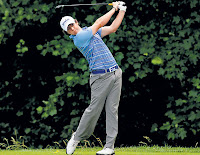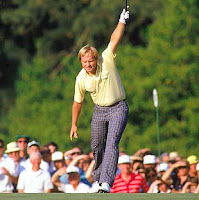
If you live in the South you might already be familiar with Bermuda grain, if you are from the North you might have no idea what grain is. But for those of us that play on it everyday or will be on a winter vacation south, you need to have an understanding of grain. Grain can make what looks like a straight putt break 6 inches or it can make a basic 10 foot put feel like you have to hit it off the green to get it to the hole. Below is information to help you understand grain.
Grain reading can be as complex or as simple as you want it to be. There are several factors that can determine the direction Bermuda grass grows, but the two I want you to be familiar with are the color of the grass (light and dark green) and uphill and downhill.
Light and Dark
If you look at the picture above you will see a typical Bermuda green. Please look at the difference in the shades of green throughout the surface. To the left, there is a very dark green area from the picture taker's vantage point, that would be into the grain. The front part of the green where you see light green will be down grain.
In general...
Light green = down grain, fast, and possibly downhill
Dark green = into grain, slow, and possibly uphill
Uphill and downhill
As a basic principle, grass grows in the direction of slope. This is because the water drains down slopes, pulling the blades of grass with the water.
In general...
Uphill putt = most likely into grain and slow
Downhill putt = most likely down grain and fast
Around the hole
When you are putting from 25 feet the first 20 feet the grain will have little effect on the putt. but the last 5 feet (when the ball starts to slow down) the grain will have much more effect on "pulling" the ball with the direction of the grain. The picture to the right shows the direction of the grass around the cup. Two things to remember around the hole:

Sharp edge of cup = high side of the hole or fast side
Jagged edge of cup = low side of the hole or slow side
It is important to pay attention to the grain around the hole because, lets say, you are putting from the lower left corner of the picture, your putt (even though it might look straight) will break to the right. If you are putting from the upper left corner, it should be very fast down grain with little break.
All of this may be a lot of information to handle, but at first just pay attention to the light and dark shades to help you with speed. When you get more confident, dive into cross grain around the hole to help you make more short-range putts.












































